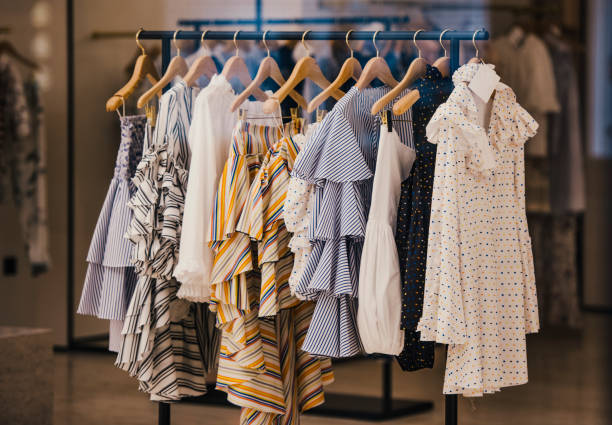Discover the most up to date Patterns in Boutique Fashion for each Period
Discover the most up to date Patterns in Boutique Fashion for each Period
Blog Article
Sustainable Fashion: Exactly How Eco-Friendly Garments Is Shaping the Future of Design
As the style market faces enhancing analysis over its environmental influence, the surge of sustainable style provides a promising choice that aligns style with eco-friendly obligation. boutique fashion. How does this movement genuinely influence the future trajectory of fashion, and what difficulties exist in advance in its extensive fostering?
Cutting-edge Lasting Products
As the style sector grapples with its ecological impact, ingenious lasting products have actually arised as a vital solution for decreasing environmental footprints. These products not just lower dependence on fossil gas yet additionally lessen dangerous chemical usage and water usage.
Along with plant-based materials, developments in biofabrication have led to the development of lab-grown fabrics. Mycelium leather, originated from mushroom roots, offers a naturally degradable and versatile choice to pet leather. Its manufacturing leads to considerably reduced carbon exhausts and water use, making it a much more sustainable choice for fashion designers seeking to line up with green techniques.
Recycled products are likewise getting grip, with polyester made from recycled plastic containers standing for a significant innovation. This innovation not just draws away plastic waste from landfills and oceans but also lowers energy consumption compared to generating virgin polyester. Together, these products underscore the possibility for an extra sustainable fashion business, paving the way for environmentally aware layout and production.
Eco-Conscious Manufacturing
Building on the advancements in sustainable products, the apparel industry is additionally re-evaluating its production processes to further minimize ecological impact. Key approaches include decreasing water intake, reducing carbon emissions, and removing dangerous chemicals. By taking on closed-loop systems, producers intend to recycle water and power successfully, substantially reducing waste. The integration of renewable power sources, such as solar and wind power, right into manufacturing centers better stops dependence on nonrenewable fuel sources.
One more essential facet is the reduction of hazardous chemicals typically utilized in dyeing and finishing textiles. Eco-conscious makers are moving in the direction of plant-based dyes and waterless dyeing innovations, which not only protect neighborhood ecosystems yet likewise boost employee safety and security. Technologies like digital printing reduce fabric waste and power usage, providing a cleaner option to typical approaches.
With the improvement of blockchain technology, companies can now provide comprehensive insights right into their supply chains, guaranteeing honest and ecologically friendly techniques at each step. As the need for eco-conscious items grows, suppliers are obliged to innovate, ensuring that the future of style is both sustainable and trendy.
The Surge of Upcycling
Upcycling, a transformative technique in sustainable style, involves artistically repurposing thrown out products right into brand-new, top quality items. This ingenious method not only minimizes waste but also lessens the need for basic materials, thus decreasing the ecological impact of clothing production. By reconstructing and reimagining existing things, designers and style brand names are able to infuse creativity right into their collections while advertising environmental responsibility.

Additionally, the upcycling movement has actually encouraged independent designers and tiny services, who typically lead in development due to their dexterity and imagination. By profiting from the plentiful availability of extra products, these entities add to a round economy, showing that fashion can be both trendy and lasting. Through upcycling, the market takes considerable strides in the direction of an extra accountable and conscious future.
Thrift Society's Effect
The burgeoning thrift society significantly improves the landscape of sustainable style, emphasizing the significance of conscious usage. This social change encourages customers to embrace secondhand garments, thereby minimizing the demand for brand-new garment manufacturing and decreasing environmental effect. Second hand shopping not just extends the Continue lifecycle of garments yet likewise reduces the carbon impact connected with manufacturing, transferring, and getting rid of clothing.
An essential facet of second hand culture is its democratization of style. By using a large variety of designs from different ages at inexpensive costs, thrift stores make fashion available to a wider audience. This availability cultivates a feeling of uniqueness and creative thinking, as consumers mix and match unique items to curate individualized wardrobes without adding to the rapid fashion cycle.
Furthermore, thrift culture promotes circularity in style, lining up with the principles of a round economic climate. By recirculating garments, the cycle of waste is interrupted, and resources are saved. This technique supports a shift from a straight "take-make-dispose" design to a more lasting framework. As more customers and designers accept second hand culture, the style industry is obliged to adjust, incorporating lasting techniques to meet the expanding need for eco-conscious alternatives.

Future Trends in Fashion
Fashion's evolution is increasingly shaped by technological innovations and sustainability-driven campaigns. As consumers become a lot more eco conscious, the sector is responding with groundbreaking developments that redefine the future of style. One noticeable pattern is the surge of electronic he said style, where digital garments can be worn in increased fact settings, dramatically reducing textile waste. This change not just caters to the digital-savvy consumer but also lessens the environmental impact generally related to garment manufacturing.
Moreover, the integration of blockchain technology uses new possibilities in openness and traceability, allowing consumers to validate the sustainability qualifications of their apparel. boutique fashion. This guarantees accountability in supply chains and advertises ethical sourcing practices. 3D printing is yet one more technology that assures to revolutionize making procedures by making it possible for on-demand manufacturing, thus decreasing excess supply and waste
In addition, the advancement of bio-fabricated materials, such as lab-grown natural leather and plant-based fabrics, offers sustainable options to traditional materials. These advancements lower reliance on animal products and resource-intensive crops. As these innovations grow, they are positioned to transform the style landscape, combining design with sustainability. The future of style, as a result, hinges on a seamless blend of innovation, innovation, and eco-friendly duty.
Verdict
The improvement of the style industry via lasting practices indicates a critical shift in the direction of environmental responsibility. This development not only lines up fashion with ecological sustainability however also establishes a precedent for future patterns focused on obligation and innovation.
As the fashion market deals with raising scrutiny over its environmental influence, the increase of lasting fashion offers a promising alternative that lines up design with ecological responsibility.As view it the style market grapples with its environmental effect, ingenious lasting products have arised as a critical service for reducing eco-friendly impacts. Together, these materials underscore the possibility for a much more lasting style market, paving the method for ecologically aware design and manufacturing.
Building on the advancements in lasting materials, the fashion sector is also re-evaluating its production procedures to better minimize environmental influence. boutique fashion.Upcycling, a transformative method in lasting style, involves creatively repurposing thrown out materials right into new, high-grade items
Report this page